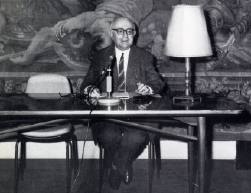ADRIAN WILLIAMS (D/USA):
"man made me"
>>> Performance text (pdf)
>>> Video documentation
>>> Deutsche Fassung
<<< Back to Overview
|  |
Unicorns do exist: At least that's what Adrian Williams makes clear in her ten-minute lecture performance in words and images. In doing so, she plays with themes from art history as well as the question of how art manipulates the human imagination.

Adrian Williams (*1979 in Oregon/USA), die 2000 als Austauschstudentin von der New Yorker Cooper Union an die Frankfurter Städelschule kam und heute in Frankfurt lebt und arbeitet, malt und zeichnet nicht. Adrian Williams liest, recherchiert und schreibt. Sie macht spektakuläre Performances, hält Vorträge und veranstaltet Dauertanzwettbewerbe, "Gladiatoren"-Wettkämpfe auf Öltonnen und moderiert eine 10-teilige Radio-Talk-Show, bei der sie gut vorbereitet mit Experten über Wetterphänomene plaudert. Der Wechsel von einem Medium ins andere hat Methode. Denn sie möchte verstehen, "wie die Welt funktioniert". Ihre "Skizzen" sind Objekte, die im Laufe der Recherchearbeiten entstehen, wie die Bonsai-Bäume, die sie als Zeitmesser sieht, vom Menschen jedoch dressiert und manipuliert. Tiere beschäftigen sie, insbesondere solche, die dem Menschen zum Symbol für Phantasien, Wünsche oder Schrecken geworden sind. Dazu zählt für sie das fliegende Eichhörnchen, das in den Mythen der Inuit lebt, das sagenumwobene Einhorn, der Vampir und der Werwolf, hinter deren mythischer Existenz sie die verborgene Wahrheit und deren Bedeutung für den Menschen sucht. Wie der Wolf sein Revier markiert, steckt auch der Künstler seine Territorien ab. "Durch die Kunst", behauptet sie, "verstehen wir die Geschichte der Menschheit." (artkaleidoscope 2/04)
Extended Biography (PDF, German)
|  |
Nach der Performance von Adrian Williams:
Spalding Gray
"Swimming to Cambodia"
Lecture Performance Film (1987)

Spalding Gray (1941-2004), actor and founding member of the Wooster Group, became famous in the 1980s with his spoken word performances - autobiographical monologues with a mixture of humour, paranoia and self-reflection that do not always clearly mark the boundary between stage character and private person.
After appearing in a few minor roles and in pornographic films, Gray gained national recognition with Swimming to Cambodia (1987), the film version of one of his monologues. Gray sits at a table throughout the film and speaks his monologue, which is based on his experiences during the shooting of the film The Killing Fields (1984) in Southeast Asia, in which Gray had a minor role, and the background he describes to the events in Cambodia that are the subject of the film - an engaging, funny, stimulating and thoughtful one-man-show.
Material:
Interview with Spalding Gray
"Shadaes of Gray" (The Observer, 26. 12. 2004)
|










